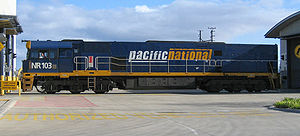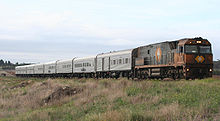- NR class
-
NR Class 
NR103 in the trial PN livery at Spotswood, Victoria Power type Diesel Electric Builder Goninan, Broadmeadow (Units 1-60)
Goninan, Bassendean (Units 61-120)Gauge 1435mm Length 22.00 m Locomotive weight 132.00t Engine type GE Transportation Systems 7FDL-16 Generator GE GMG196 Traction motors GE 5GE793A1 Top speed 115 km/h Power output 3000 kW (4020 HP) Number in class 119 Number NR1-NR2, NR4-NR32, NR34-NR121 The NR class are an Australian mainline diesel electric locomotives introduced by National Rail in 1996. They were the only locomotives ordered by National Rail, thus being named the "NR" Class. Australian designed and built by Goninan, the 120 units use imported GE Transportation Systems engines and traction equipment.
Contents
History
Upon commencing operations in April 1993 the National Rail Corporation inherited a diverse collection of rolling stock to operate interstate freight operations in Australia.[1] The fleet included locomotives of mixed age and power provided by Public Transport Corporation of Victoria, the State Rail Authority of New South Wales, and the Australian National Railways Commission.
United Goninan obtained the contract for 120 locomotives from National Rail. Because it was a locomotive to be used "Australia Wide", along with the specification of rapid delivery of one per week, two United Goninan plants were used to construct the class - Broadmeadow (NSW) and Bassendean (WA). The Broadmeadow plant constructed NR 1–60, while the Bassendean plant constructed NR61–120.[2] The plant at Hexham (NSW) built the frames, while their Taree plant painted most of the Broadmeadow built units.[2]
The first unit to be completed was NR1 which commenced trials on 23 September 1996. The first Bassendean built unit (NR61) was despatched on 26 September 1996 to Port Augusta, passing though Melbourne on the 28th and arriving into Sydney on the 29th.[2] The units were initially delivered without National Rail branding or logos, but later units were delivered in full livery. Testing of the units was carried out in NSW between Werris Creek and Maitland using ballast hoppers and 442 class locomotives in dynamic braking mode as dynamic loads. 10,000 km of trouble free running was required of each unit before acceptance.[2] In October 1997 Bassendean delivered their sixtieth NR class, delivering just over one locomotive a week as required in the contract.
As well as supplying the locomotives, Goninan was required to maintain the entire NR fleet. A depot was built alongside the Newport-Sunshine railway in the western Melbourne suburb of Spotswood for this reason.[3]
Into service
With the arrival of the class, National Rail was able to return leased units to their owners, including FreightCorp 422, 80, 81, and 82 class units; Silverton Tramway Company 442 class; and V/Line C class units. The relatively new EL class were also removed from the National Rail roster in November 1997.[2] Once all 120 units were delivered, the National Rail fleet still included AN, BL and DL class units, along with thirteen 81 class and several hired G class. The new locomotives were placed on time sensitive trains first.[2]
When first delivered, the NR class were banned from running in New South Wales by the Environment Protection Authority due to excessive noise when under dynamic braking but the ban was lifted after further testing. The class could also not lead on the Victorian standard gauge network due to the lack of suitable radio equipment. In later years NR76 to NR98 were provided with V/Line Section Authority System equipment to work the Melbourne-Adelaide railway, while NR1 to NR13 and NR61 to NR72 were fitted with V/Line radios to operate on the Victorian North East standard gauge line.[4]
Great Southern Railway commenced using NR class locomotives from their formation, the first train running with NR77 on 1 November 1997.[3] In 2000 National Rail begun to negotiate with drivers to operate driver only trains between Brisbane and Taree, Junee to Port August via Melbourne, and Kalgoolie to Perth.[3]
With the sale of National Rail, ownership of the class passed to Pacific National. NRs 81, 82 and 83 were leased to competitor Specialised Container Transport for a period of time as part of an Australian Competition and Consumer Commission (ACCC) ruling.[5]
Accidents
NR3 was involved in an accident at Robertson, NSW, resulting in the death of two crew members. It was rebuilt and renamed NR121. NR109 was involved in an accident while on a Ghan service in 2006, hitting a truck at a level crossing, being repaired. NR33 was involved in level crossing incident in June 2006, being the third locomotive on a Melbourne to Adelaide freight service, behind DL 40 and NR 52 (lead locomotive). NR33 was buried under 20 wagons and was subsequently written off and scrapped due to irreparable damage.[6]
Features
The NR Class introduced many new features that other older locomotives lacked. These were the first locomotives in Australia to have "variable horsepower", which meant that the power output of the engine had three different settings, making the NR class the most fuel efficient locomotives in Australia. They have GE 7FDL-16 engines, with power levels of 2850HP, 3560HP or 4020HP, mass of 132t, a Co-Co wheel arrangement and a maximum speed of 115 km/h.
The NR Class cab was designed taking into consideration the results of an extended consultative process with the end users. This has resulted in a cab that has been well accepted. The layout of the control stand evolved from a British Rail Class 60 cab, and is substantially different from the more common AAR type I (stand) and Type II (desk) cabs.[7]
The design is a long hood unit locomotive, with only one cab but two separate sets of controls, which allow it be driven either "A" or "B" end leading. This locomotive had to pass all tests, such as being able to shunt if required, drive "long end leading" if needed, and allow drivers to do checks on fuel, brakes, and sand. Despite the twin controls, operation of the class number 2 end leading is avoided, with single NR classes being turned on turntables to ensure they face the correct way.[3]
Livery
On entry to service the class were painted in the orange and grey National Rail livery, with a few exceptions. NR30 and 52 were painted in Aboriginal artworks, intended to be used on GSR services. The locomotives were delivered in plain grey and black, with the artwork being applied soon after. Railfans dubbed the locomotives snake and pizza.[3] The green "Trailerail" livery was applied to NR53, 54 and 55. NR56 and 57 received the blue and white "Seatrain" livery. NR58, 59 and 60 received the grey and white "Steelink" livery.[3]
Many locomotives have been named, the first being done on delivery.[4] They were done at operational convenience rather than in groups of numbers. Names include cities and suburbs served by National Rail, in addition to their depots and maintenance centres. The special livered locomotives were given related names. It had been intended to name all locomotives, but by February 2000 only 70 had been named,[4] a number not much larger today.
In later years for Great Southern Railway services NR74, 75 and 109 were painted in the red The Ghan livery while NR25, 26, 27 and 28 have been painted in blue Indian Pacific In 2011 a new yellow & grey design for the Indian Pacific was released on NR18. With Pacific National ownership further changes were made, the 'Pacific National' decals placed over the side air deflectors replacing the 'National Rail' signage. From 2006 the National Rail 'diamonds' on the side and ends of the locomotives were removed or painted over. Full repainting has also been carried out with NRs 8, 29, 73, and 103 painted in the blue and yellow Pacific National livery (NR103 has a trial Pacific National livery: an all-over blue scheme), while NRs 1, 4, 9, 10, 11, 12, 14, 16, 20, 21, 22, 23, 24, 30, 31, 32, 34, 35, 36, 37, 38, 39, 40, 41, 42, 43, 44, 45, 46, 47, 48, 49, 50, 51, 52, 53, 54, 55, 56, 57, 58, 59, 60, 61, 67, 68, 69, 71, 76, 77, 78, 81, 86, 88, 91, 92, 93, 94, 96, 99, 100, 101, 105, 106, 107, 108, 110, 112, 113, 115, 119 and 121, have been repainted into the Pacific National 'Intermodal' livery which includes the Southern Cross at the rear of the locomotive side carbody. This repaint program is continuing and almost complete.
In 2008 NR84 and NR85 were repainted into a green and white The Southern Spirit livery.[8] Railfan speculation has suggested further locomotives will be repainted for Great Southern Railway services, including The Overland for the first time, as well as updated Indian Pacific and The Ghan liveries.[9]
See also
References
- "VICSIG - Locomotives - NR Class Diesel-Electric". vicsig.net. http://vicsig.net/index.php?page=locomotives&class=NR&orgstate=A&type=Diesel-Electric. Retrieved 2008-05-17.
- "Pacific National: NR Class". locopage.railpage.org.au. http://locopage.railpage.org.au/sra/pn_nr.html. Retrieved 2008-05-17.
- "QRIG.org - Goninan/GE NR Class". www.qrig.org. http://www.qrig.org/motive-power/pacific-national/goninan-ge-nr-class/. Retrieved 2008-05-17.[dead link]
Footnotes
- ^ "Background - Organisation of Australia's Railways". www.infrastructure.gov.au. http://www.infrastructure.gov.au/rail/trains/background/index.aspx. Retrieved 2008-11-10.
- ^ a b c d e f Antony Fitzgerald (April 2000). "The Dash 9 in Australia: National Rail's NR class". Australian Model Railway Magazine: page 27.
- ^ a b c d e f Antony Fitzgerald (April 2000). "The Dash 9 in Australia: National Rail's NR class". Australian Model Railway Magazine: page 29.
- ^ a b c Antony Fitzgerald (April 2000). "The Dash 9 in Australia: National Rail's NR class". Australian Model Railway Magazine: page 30.
- ^ "ACCC requires "clean break" between Toll Logistics and infrastructure companies". Australian Competition and Consumer Commission. 2007-04-18. http://www.accc.gov.au/content/index.phtml/itemId/784962/fromItemId/2332. Retrieved 2008-08-31.
- ^ "NR33 Under the Torch". Railpage Australia Forums (Locomotives and Rolling Stock). www.railpage.com.au. http://www.railpage.com.au/f-t11338283-0-asc-s0.htm. Retrieved 2008-11-10.
- ^ Hussey, F. (2005). How the NR Class got their cabs: in The NR Class - a Loco for Australia. Railway Digest, 43(9), 29.
- ^ "NR85 Southern Spirit". railsa.org. http://www.railsa.org/forum/viewtopic.php?f=13&t=2746. Retrieved 2008-09-02.
- ^ "NR Class Repaints". Railpage Australia Forums (Locomotives and Rolling Stock). www.railpage.com.au. 14 September 2008. http://www.railpage.com.au/f-p1112581.htm#1112581. Retrieved 2008-11-10.
External links
 Media related to NR class at Wikimedia Commons
Media related to NR class at Wikimedia Commons- NR Class Repaints, sightings of repainted locomotives on the Railpage Australia online forum
- Sightings of NR locos, sightings of any NR locomotive in Australia on the Railpage Australia online forum
Categories:- Diesel locomotives of Australia
- Co-Co locomotives
- Railway locomotives introduced in 1996
Wikimedia Foundation. 2010.

